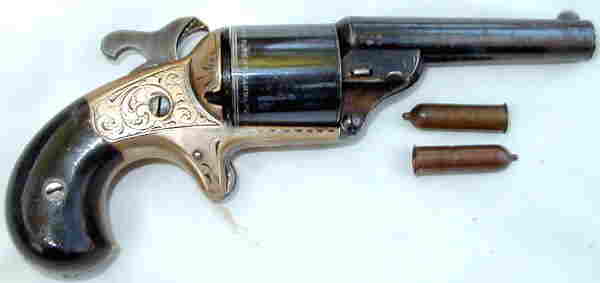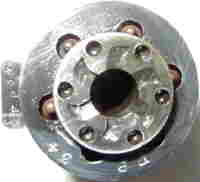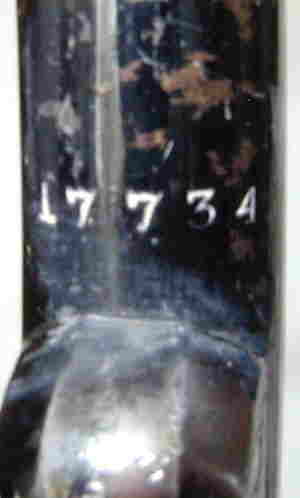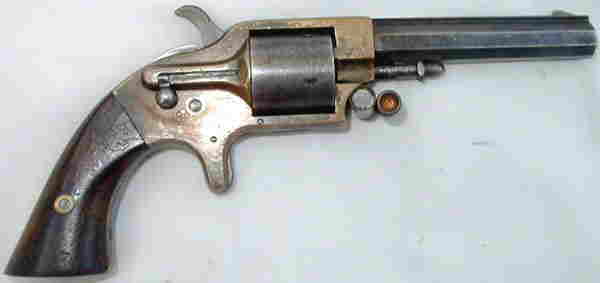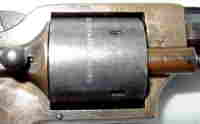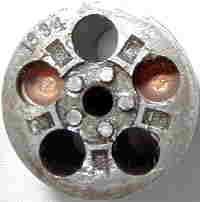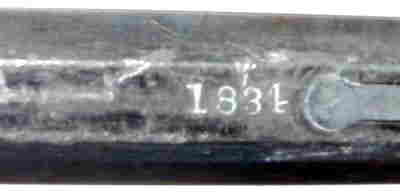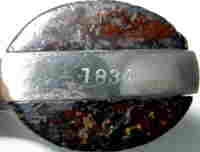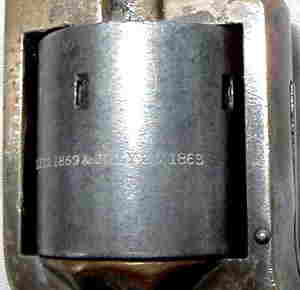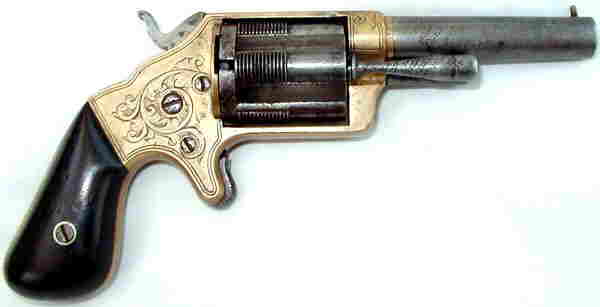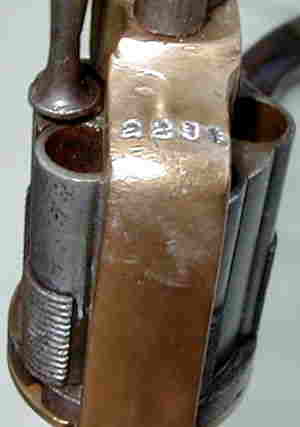|
|
|||||
|
The
Case Of |
|||||
| Horace Smith & Daniel Wesson formed their second partnership (S&W) in 1856 for the development and manufacture of a revolver chambered for a self contained metallic cartridge. During this development period, while researching existing patents, it was found that a Rollin White had patented a bored through cylinder for a paper cartridge some time earlier. Since this same cylinder design would serve S&W well they negotiated with Rollin White for assignment of the patent. This was granted with S&W agreeing to pay Rollin White a small royalty on every pistol sold with the provision that Rollin White would pay any legal fees associated with the defense of his patent and infringements thereto. |
|||||
| The success of S&W's metallic cartridge revolvers starting in 1857, gave host to a large amount of copy cat type weapons, some outright and without question infringements of White's patents, and others not of the exact design, but designed exactly to circumvent the White and S&W patents, being manufactured by a host of competitors. American ingenuity was not to be denied and other manufacturers quickly developed unique metallic cartridge and cylinder designs to circumvent White's and S&W's patents. Poor Rollin White. He had his hands full and his pocketbook emptied in bringing patent infringement suits. The courts ultimately ruled in his favor in 1862 with full implementation not taking effect until 1865. White's patent of the bored though cylinder finally expired in 1871 or 72. But not before he went broke from the litigation costs. | |||||
| Among the more unique of the patent infringements were the following 3 weapons manufactured by Moore's Patent Firearms Company, Plant's Mfg. Company and Brooklyn Firearms Company. |
|||||
|
|
|||||
|
Top to bottom: |
|||||
| Moore's Patent Firearms Company's Front Loading "Teat Fire" Cartridge Single Action Pocket Model Revolver with top and side views of "teat fire" cartridges. |
|||||
| Plant's Manufacturing Company's Front Loading "Cup Primed" Cartridge Single Action Pocket Model Revolver with top and side views of "cup primed" cartridges. | |||||
| Brooklyn Firearms Company's Side Loading Slocum "Rim Fire" Cartridge Single Action Pocket Model Revolver with top and side views of standard "rim fire" cartridges which were loaded by sliding the individual chamber tubes forward and laying the cartridges in the exposed cut outs from the side and sliding the chambers back to the rear. | |||||
|
|
|||||
|
The
Moore Front Loading "Teat Fire" Cartridge
|
|||||
|
|
|||||
| Approximately 30,000 of this revolver were made circa 1864 to 1870. It utilized a special .32 caliber teat-fire cartridge designed by Daniel Moore and David Williamson. It was loaded from the front with the "teat" to the rear. |
|||||
| This 6 shot revolver has a 3¼" barrel. Overall it measures 7-1/8" It has a brass frame which at one time may have been silver plated. The barrel and cylinder have 98%+ of the original deep blue finish. The bird's head butt has 2 piece walnut grips. This model has a small hinged swivel gate on the right side of the barrel lug in front of the cylinder that prevents the cartridges from falling out after they are inserted. | |||||
| The barrel markings are "MOORE'S PAT. FIREARMS CO. BROOKLYN, N.Y.", in a single line on the top and horizontally, on the bottom, the number "17734". The cylinder is marked, at the rear, "D. WILLIAM'S PATENT JANUARY 5/1864". The stamping "FP 34" can be found on the frame under the grips, on the inside of the grips themselves and on the back of the cylinder and barrel wedge. | |||||
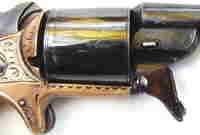
Swivel Gate - Right Side Of Gun |
|
||||
|
|
|||||
|
|||||
|
|
|||||
|
|
|||||
|
Plant's
Front Loading "Cup Primed" Cartridge
|
|||||
|
|
|||||
| This revolver was made in the mid 1860's with the total quantity being about 20,000. It is a 5 shot, 30 caliber, cup-primed front loader. It has a 3½" octagon ribbed barrel, a brass frame, originally silver plated with a blued barrel and cylinder. Overall it is 8-1/8". It has a spur trigger, rosewood grips and a squared butt. A ejector rod is mounted on the right side within a grooved housing. |
|||||
| The barrel markings are "MERWIN & BRAY-FIRE-ARMS CO. N.Y.", in a single line on the top and underneath the cylinder pin is the serial number, "1834". "1834" is also stamped on the bottom of the butt strap. The cylinder is marked "PAT. JULY 12, 1859 & JULY 21, 1863". | |||||
|
Plant Ejector Rod (Forward) |
Front And Rear Of Partially Loaded Cylinder |
||||
|
Top And Bottom Barrel Markings |
|||||
|
|||||
|
|
|||||
|
|
|||||
|
Brooklyn
Firearms "Slocum" Side Loading
|
|||||
|
|
|||||
| Approximately 10,000 Slocum revolvers were manufactured from 1863 to 1864. It is a 5 shot, .32 caliber, rim fire front (side) loader. It has a 3" round barrel, a brass frame, originally silver plated, with a blued (now gray) barrel and cylinder. It is 9½" overall. It has a spur trigger, irregularly shaped bag-like handle with 2 piece walnut grips. It is of unique design with individual chambers in the form of sliding tubes within cut-outs on the cylinder. The chambers slide forward, one at a time, over a fixed rod on the right side to expose, load and eject. |
|||||
| The barrel marking is "B. A. Co. PATENT APRIL 14, 1863", on the top, in a single line. The serial number "2294" is stamped on the bottom front of the frame. | |||||
|
|||||
|
|
|||||
| All three of these pistols represent attempts at circumventing the Rollin White patent. Each was successful for a period of time until Rollin White won his case in full but lost his fortune in doing so. Dave Radcliffe |
|||||

